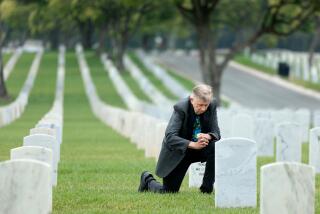In War, They Don’t Ask What Race You Are
- Share via
A reporter knows when a difficult interview is about to occur. Sometimes, you can sense it from the subject matter or the interviewee’s attitude and demeanor.
I knew instantly that Eddie Morin would be tough for me to interview. When I met him the other day at Fourth Street School in East L.A., where he was painting a mural for the library, I learned he has a calming presence and a knack for asking questions quietly and thoughtfully.
I was hoping I could interview him without him turning the tables on me. But it didn’t work. I sat there, for more than two hours, grappling with pain that I wish would just go away.
He got me to talk about Vietnam.
*
I went to interview Morin because he has decided to do a sequel to his father’s book, “Among the Valiant.” It wasn’t a best-seller at the time of its release, but it became an oft-quoted source on the contributions Mexican Americans made while serving in the U.S. armed forces during World War II and the Korean War.
Raul Morin was outraged because he felt Mexican Americans were being taken for granted. He wrote the book, published in 1963, to prove that Americans of Mexican descent were as patriotic as their countrymen.
Among other things, he revealed in his book that Mexican Americans earned more Medals of Honor--17--than any other ethnic group in the U.S. military during World War II and the Korean War.
“We feel just as proud of the Colin Kelleys, the Dobbie Millers and the Sadio Munemoris,” Raul Morin wrote of Medal of Honor recipients, “as we are of the Martinezes, Garcias and Rodriguezes.
“All America should know of the great contributions made by the Mexican American soldiers. . . . In this way they can better understand today’s brother American and lessen the few remaining stigmas harbored against the Spanish-speaking people to help promote a better democracy for all who live in America.”
However, he never got to write a sequel. A disabled veteran from East L.A. who fought in Europe with the Army’s 79th Infantry Division, he died in 1967 at age 54.
But Eddie decided last summer to write a sequel, believing the public has ignored the contributions of Chicanos and other Latinos in later wars, particularly Vietnam.
“There’s a lot of discrimination against our people,” he says, “especially now with all the immigrant bashing going on. When there’s a war going on, they don’t ask what race you are. They just want you to serve.”
He knows that in Latino homes throughout the Southwest, a focal point is the place where the military photos of a family’s sons and daughters are displayed. “Just about every home has such a place,” he says.
Morin told me of the veterans he had tracked down for his book.
There’s the Chicano from Bakersfield who saved his squad from annihilation during a firefight in 1966. He was part of a detail of the 1st Infantry Division to help rescue a platoon under attack by a North Vietnamese army unit near Saigon.
He was told by his platoon leader to hold his position to prevent his squad from being overrun.
He did so, killing an unspecified number of North Vietnamese regulars with a machine gun he picked up during the close-quarter fighting. Wounded in the face, shoulder and foot, the Chicano, now 48, shrugged off the incident.
“I never told anybody about it,” he says, adding his involvement may have been overlooked because some incorrectly assumed he had been killed in the fighting.
He later discovered that at least two members of his unit, including his platoon leader, received the Silver Star, the Army’s second highest military award, for bravery.
He is asking the Army for a Silver Star for his actions near the village of Di An, but he’s afraid of the spotlight. He refuses to speak publicly about his experience or have his name published while he seeks the award.
“It’s for people like him,” Eddie says, “that I’m doing this.”
*
Eddie’s eyes narrowed on me when I told him I served with the Americal Division as a young artillery lieutenant in Vietnam.
The reason for my fear of interviewing him was apparent because now the tables were turned. I talked of how I felt about the people I had killed in combat and my angry reaction to anti-war protesters, the very people I had agreed with on Vietnam.
The pain is still there.
He was taking notes, occasionally taking off his glasses to nod his head, as I told him about 35 GIs who were killed in 1971 when a firebase named Mary Ann was overrun and what I had to do in retaliation.
It was the toughest interview I’ve ever given.
More to Read
Sign up for our Book Club newsletter
Get the latest news, events and more from the Los Angeles Times Book Club, and help us get L.A. reading and talking.
You may occasionally receive promotional content from the Los Angeles Times.







